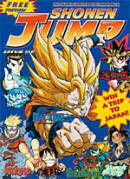
by Gerry Poulos
I've been to a number of "press-previews" in my day and upon receiving an invitation from Viz to an event officially announcing their new project, a US version of Shonen Jump, I decided to attend. I assumed it would be your run of the mill Q&A panel along with a glass of water and maybe some "Chex Mix" - or dare I hope - cold cuts and soft drinks (it was seven-o'clock, and, after a long day of traveling, I hadn't yet eaten). I was mistaken. Upon arriving at the very elegant Westin Horton Plaza, I noticed a decisively "classy" feel that I had not experienced at other "previews." I registered at the table and picked up the standard-issue "My Name Is" label and waited with the other attendees for the event to begin. While waiting I noticed that of the many people present, the press seemed to be in the minority. I wondered what would draw so many non-writing folks to what I assumed would be an informative, yet somewhat dull, evening of talk about manga. I mingled and chatted with some of the other guests and was graciously introduced to some of Viz's VIPs. I waited outside the closed double doors leading to the event room with everyone else and was starting to wonder what was going to happen. As usual for these things, it was running a little behind but not enough to cause the guests to grow impatient. I did notice, however, a certain feeling of anticipation developing. Finally, the doors were opened and smoke bellowed from the room to a pulsing, techno-punk, beat. The large room was draped entirely in black as strobes on high-tech scaffolds flashed bright colors and images of Dragonball and Yu-Gi-Oh! on the walls. As the initial surprise passed, the one hundred or so guests sauntered into the room. Once inside, the room revealed waiters bearing wine and champagne, two open bars, dessert tables, a Tex-Mex buffet and even sushi. At the front of the room was a platform with a number of chairs and several displays of manga novels, including titles like Dragonball. In front of each chair was a placard bearing the name of the dignitary to be seated there. Among those names were: Seiji Horibuchi, founder of VIZ Communications; Kazuhiko Torishima, Senior Editorial Director of Shonen Jump 's Japanese publisher, Shueisha, Inc; Rick Bauer, Senior Vice President, Sales & Marketing of Viz; Jason Thompson, U.S. editor of Shonen Jump and Paul Condolora, Vice President and General Manager of the Cartoon Network New Media.
After what seemed a very short hour of food, drink, and mingling, the presentation started. After introductions, Mr. Seiji Horibuchi, attributed by many to be the pioneer in the bringing of manga to Americans, kicked off the presentation. Horibuchi-san explained that the mission of Shonen Jump is to bring manga into the mainstream of American youth and, in so doing, bring them closer to other youth around the world who share an appreciation of manga. Mr. Horibuchi then announced, with pride, a co-ownership between Viz Communications and Shueisha, Incorporated. He continued to explain that, "The relationship between Viz and Shueisha is not licensee: licensor anymore. We are now business partners." Concluding his comments, Mr. Horibuchi then introduced, as the "heart and soul of Shonen Jump in Japan," Mr. Kazuhiko Torishima. Mr. Torishima opened by explaining that, "All the children in Japan typically read one magazine from the age of ten - and that is the weekly Shonen Jump." He explained how Shonen Jump, beginning in 1968 with a circulation of 108,000, now has a circulation of 3.4 million. He stated that, "It is now the world's most popular magazine that is supported by the youth in Japan." After explaining the process of how manga is introduced in Shonen Jump, Torishima-san made note that the Dragonball graphic novels, which are collections from Shonen Jump's pages, sold 120 million copies and Yu-Gi-Oh! has sold 25 million copies. Torishima then stated, "To put this into perspective: At the end of 2001, Harry Potter, with four volumes, sold roughly 55 million copies worldwide. A total of 900 million volumes of graphic novels based on weekly Shonen Jump titles have been published between June of 2001 and May of 2002." In conclusion, Mr. Torishima said, "We'd like the American youth to become familiar with manga and the most popular manga magazine from Japan - the weekly Shonen Jump and hear their views. It is our profound desire to begin creating new manga with the new American audience." |


